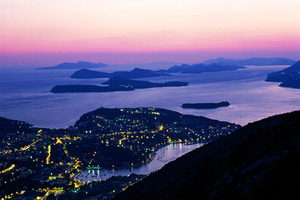A newly identified fault running under the Adriatic Sea is building more of Croatia's Dalmatian Islands and bulking up the Dinaric Alps, a new study says.
Both the islands and the mountain chain - which runs along the upper western coast of the Balkan Peninsula - were believed to have stopped growing 20 million to 30 million years ago.

|
| ©Dario Mitidieri/Getty Images
|
| A previously unknown active fault off the coast of Croatia is creating new additions to the Dalmatian Islands, according to a new study. The fault lies northwest of the southern town of Dubrovnik, seen above at sunrise with several of the islands in the distance.
|
But scientists found that at the new fault the leading edge of the Eurasian tectonic plate is sliding over the South Adria microplate.
"The southern Adria microplate is covered by a thick layer of buoyant rocks called carbonates," said lead researcher Richard A. Bennett of the University of Arizona in Tucson.
"As the Adria plate moves northeast toward Europe, the carbonate layer is scraped off of the microplate, much like snow in front of a snowplow."
Carbonates get piled up on the seafloor in front of the moving plate, forming new islands. Over millions of years the islands are squeezed together like folds in an accordion, which creates new additions to the nearby Dinaric Alps.
What's more, the fault is causing the southern "boot heel" of Italy to move toward the Croatian coast at a rate of about 0.16 inch (0.4 centimeter) a year, while the Adriatic seafloor is sliding under Croatia.
"If this process continues, eventually the seafloor will be completely consumed, bringing Italy into contact with Croatia," Bennett said.
This scenario means the Adriatic Sea could close up in about 50 million to 70 million years.
Geologic GPSThe new fault spans at least 124 miles (200 kilometers) along the seafloor northwest of Dubrovnik in southern Croatia (
see map).
It runs under the Dalmatians, which consist of 1,185 islands off Croatia's coast that have become a popular tourist destination. (See photos of kayaking along the Croatian coast.)
Bennett identified the fault using a technique called geodesy, which records the positions of rocks at a given time - similar to the way geographic positioning systems track people or objects.
Some of Bennett's colleagues in Croatia started taking geodetic measurements in 1994.
In 2005 and 2007 Bennett and his team repeated those measurements and began to realize that the ground motions had the telltale pattern of a thrust fault - a geologic feature where one plate moves up and over another.
"Then we started to put the pieces together," Bennett said.
"We recognized the long-term relationship between the fault and the islands and the mountains. It all began to make sense."
The team describes their results in the January issue of the journal Geology.
Chuck DeMets is a geologist at the University of Wisconsin, Madison, who was not involved with the study.
He noted that scientists already knew about the existence of multiple faults in Croatia.
"Bennett and his co-authors demonstrate that it is conceivable that a single master fault underlies these other faults and show that their data are adequately fit by this model," DeMets said.
"Additional observations may well show such a model to be overly simplistic, in which case the proposed master fault may not exist," he continued.
"However, they are already collecting additional data that will allow them to test their new model and possibly more complex models."
Tsunami RiskIn the meantime, the new finding should be considered when gauging the region's earthquake and tsunami potential, the scientists suggest.
Previous calculations to assess these possibilities did not consider this fault to be active.
"We do not know, given the current data, whether or not the fault along which the motions take place is accumulating strain that will be released during a large future earthquake, or alternatively whether the strain is accommodated without earthquakes," study author Bennett said.
"All indications are that the fault could produce a very large earthquake, but additional research is required to confirm this result," he said.
"If the fault is capable of producing very large earthquakes, it could also be capable of generating a tsunami, because the fault is underwater."
Reader Comments
to our Newsletter